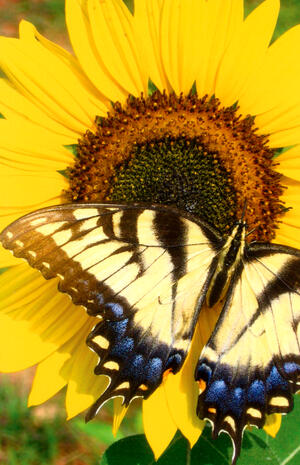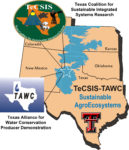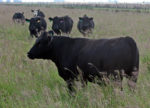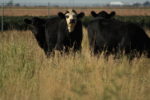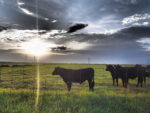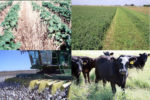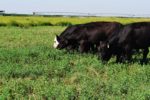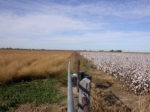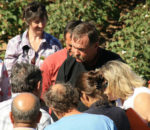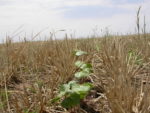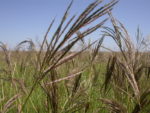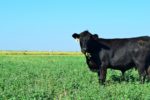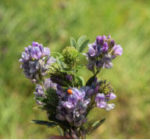For nearly 20 years, Texas Tech University and its many research partners have studied diversified crop and livestock production systems to address the growing need for water conservation, while keeping soils fertile, crop yields profitable, cattle production thriving, and surrounding communities viable in the Texas High Plains. The research looks at alternatives to monoculture cotton production in the region and how those systems can be sustained over the long-term. These series of bulletins showcase the results of these long-term crop/livestock production systems, and how those results are being translated into practical field production practices and sustainable agriculture applications. The bulletins cover such topics as sustainable agroecosystems, crops and soils, and water conservation.
Sustainable Agroecosystems
Sustainable Crop/Livestock Systems in the Texas High Plains: Phase I
Sustainable Crop/Livestock Systems in the Texas High Plains: Phase II
In the Southern SARE-funded project (LS02-131), “Forage and Livestock Systems for Sustainable High Plains Agriculture,” research continued into Phase II with the addition of dryland grazing systems and deficit-irrigated forage-livestock grazing systems.
Sustainable Crop/Livestock Systems in the Texas High Plains: Phase III
In the Southern SARE-funded project (LS08-202), “Crop-Livestock Systems for Sustainable High Plains Agriculture,” the project continued into Phase III with system modifications and revisions to target greater water savings and profitability, and address emerging issues.
Diversifying in the Texas High Plains: Examples of agroecosystems models
The following system configurations are examples of the diversified crop/livestock production practices that have been studied across the Texas High Plains since 1997. These systems have been tested against cotton monoculture –a subsurface drip-irrigated system farmed with conventional cultural practices recommended for the High Plains region.
Agroecosystems Economics in the Texas High Plains: A 10-year analysis, 1999-2008
Based on 10 years of Texas Tech University research, integrated cotton-forage-beef cattle systems are just as profitable as cotton monoculture systems. But there’s more. Integrated crop-livestock systems use less irrigation water, are more energy efficient, preserve soils by reducing wind erosion, and have a lower economic risk related to specific-loss events, such as a drought.
Agroecosystems Research in the Texas High Plains: Graduate student studies
Since 1997, over two dozen Master’s, PhD, and visiting students have conducted research and published articles related to sustainable integrated systems research in the Texas High Plains.The following are examples of current studies by Texas Tech University graduate students.
Water Conservation
Water Conservation in the Texas High Plains: A systems research model of sustainable agroecosystems
The objective of the initial SARE grant, (LS97-082), “Sustainable Crop/Livestock Systems in the Texas High Plains,” was simple: Demonstrate that farmers can save water through an alternative production approach to monoculture cotton.
Texas Alliance for Water Conservation: Farmers teaching farmers how to manage water like money
For over a decade, producers across the Texas High Plains have been educating other producers on production methods and new technologies that help save water.
Crops and Soils
Soil Quality of Integrated Crop/Livestock Systems: Enhancing soil carbon sequestration and microbial diversity
In the Southern SARE-funded study (LS10-229), “Integrated Crop and Livestock Systems for Enhanced Soil Carbon Sequestration and Microbial Diversity in the Semi-arid Texas High Plains,” Texas Tech University researchers evaluated integrated crop/livestock systems for long-term soil quality by assessing microbial activity and soil carbon storage.
Cover Crops and Cotton in the Texas High Plains: SARE research summary, 2007-2009
In a Southern SARE-funded Graduate Student Grant (GS07-056), “Allelopathic Effects of Small Grain Cover Crops on Cotton Plant Growth and Yields,” Texas Tech University researchers investigated allelopathy as the possible cause of the observed suppression and to incorporate livestock grazing as a means of reducing the allelopathic effects on the cotton crop.
Water Use of Old World Bluestems in the Texas High Plains: SARE research summary, 2001-2003
In a Southern SARE-funded Graduate Student Grant (GS02-012), “Optimizing Water Use for Three Old World Bluestems in the Texas High Plains,” Texas Tech University researchers evaluated three old world bluestem species under dryland, and low, medium and high irrigation levels to determine water use efficiency, yield and nutritive value over a three-year period.
The Performance of Cover Crops in Minimally Tilled Forage-based Grazing Systems
In a Southern SARE-funded Graduate Student Grant (GS15-152), “Evaluation of Winter Annual Cover Crops Under Multiple Residue Management: Impacts on land management, soil water depletion, and cash crop productivity,” Texas Tech University researchers investigated five cover crops species as potential complements to a warm-season beef-stocker grazing system. The impact of the project was two-fold: Stabilize the soil surface from excessive wind erosion and desiccation; and strengthen rural communities by ensuring the persistence of profitable agriculture in the region.
Integrating Legumes with Grass to Improve Forage-Livestock Systems
In a Southern SARE-funded Research and Education Grant (LS14-261), "Long-term Agroecosystems Research and Adoption in the Texas Southern High Plains -- Phase III," Texas Tech University researchers conducted a steer grazing trial comparing a grass only system to a grass-legume system for animal productivity and water use efficiency.
Published by the Southern Region of the Sustainable Agriculture Research and Education (SARE) program. Funded by the USDA National Institute of Food and Agriculture (NIFA), Southern SARE operates under cooperative agreements with the University of Georgia, Fort Valley State University, and the Kerr Center for Sustainable Agriculture to offer competitive grants to advance sustainable agriculture in America's Southern region. This material is based upon work that is supported by the National Institute of Food and Agriculture, U.S. Department of Agriculture, through Southern Sustainable Agriculture Research and Education, under sub-award numbers: LS97-082, LS02-131, LS08-202, LS10-229, LS11-238, LS14-261, LS17-286, GS02-012, GS07-056, GS15-152 and GS18-196. USDA is an equal opportunity employer and service provider. Any opinions, findings, conclusions, or recommendations expressed in this publication are those of the author(s) and do not necessarily reflect the view of the U.S. Department of Agriculture.
